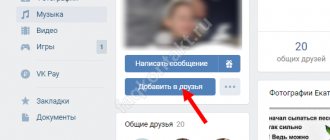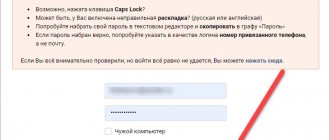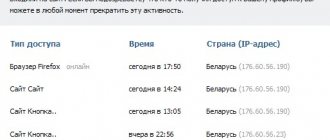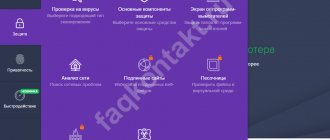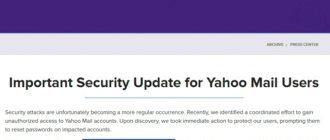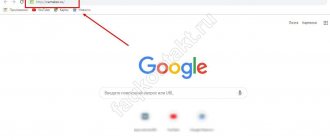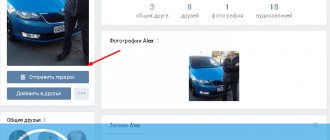To make using the social network comfortable for every person, the developers tried to create as many personal profile settings as possible. You can not only provide your personal data to each user, but also hide it. For this purpose, options such as “Closed profile” and blocking unwanted pages were created. Today we will tell you how to log into Odnoklassniki if access to the account is closed by the owner himself, and what to do if access to the social network is restricted at work.
How to block your contact page from search engines? (Yandex, Google, etc.)
In the upper right corner click on the avatar. Select " Settings
».
Select the “ Privacy”
"
Scroll down to the “ Other
” block. Opposite the line “Who can see my page on the Internet” set the value “”.
If you have the old VKontakte design active
Go to the “ My Settings”
", the "
Privacy
" tab and opposite the very bottom line "Who can see my page on the Internet" set the value to "
Only VKontakte users
".
To check if you did everything correctly, do the following. Select “ My Page”
", then click on "
Log Out
".
After this, the following message should appear. « The page is available only to authorized users
».
How to log into Odnoklassniki if access is blocked at work?
If an employer does not approve of the communication of its employees on social networks, then it tries in every possible way to prevent this and blocks access to certain sites.
To also continue chatting on the platform, you can simply download the mobile app to your phone. If you don’t have a smartphone at hand, then try using an anonymizer, for example, pingway.ru. This is a site that hides your activity on the Internet and helps you bypass established blocks.
How to close your VKontakte page from other users?
You can close the entire page, or some part of it, from VKontakte participants in the same way - by going to the settings section, the “ Privacy”
" and setting the settings properly.
(Most often in the meaning “ Only me
”). Each item is described in detail, so you can figure out what is responsible for what.
Go to the VKontakte website https://vk.com/. In the address bar (at the top of the window) put “/” and write search. Press Enter.
Step 2
A search window will open. In the line, enter the first and last name of the person whose page you are looking for. If there are many people with the same name, fill out the advanced search form on the right.
Step 3
You go to the page and look at it. What to do if “The page is available only to authorized users.”? There is a solution! Do you know who has this person as a friend? If so, find a “middleman.” For example, you searched for Vasya Pupkin, and his “Page is available only to authorized users.” Vasya is a friend of Ololoshi Ololoev. So, look for this Ololosha Ololoev.
Step 4
Once you find him, look at his friends list. Have you found the person you need? Hover over his photo and click “Enlarge”. Below the photo you will see this (look at the picture). Click on “Photos from Page...”. A window will open with all the photo albums of the person you need.
Step 5
What should you do if you go to Ololoshi Ololoev’s page, but there is no list of his friends? The answer is simple: if Pupkin is his friend, he probably liked it. Open any photo and see the list of people who liked it. Have you found the person you need? Hover over his photo and click “Enlarge”.
The vast majority of sites are freely accessible and free for users. However, there are resources that offer additional information and subscription to paid services that require a procedure such as authorization. What does this give to users?
The user needs to fill out a form to create a domain with a personal login and password. A login is a unique name that is presented to a user on a given site. Typically, there cannot be two identical logins on one site. As for the password, it is a coded secret word or a certain sequence of characters. It confirms the fact that you are the owner of this login. For security purposes, when you enter your password, it is displayed with asterisks. There are sites that offer you to choose your own login and password, while others generate them yourself.
How to view a page if you are blacklisted?
If you are “lucky” to be blacklisted, you will not be able to see the page information. It simply ceases to exist for you. But there are several ways to view the data, provided that they do not belong to the category of closed profiles:
- Use another account. For example, ask your friend to find a user or create a new page.
- Find a person through a browser. You need to enter your last name, first name, place of residence in the search bar and add the word “Odnoklassniki”. After this, all that remains is to check the results and find the right one. If all else fails, then you need to add additional profile information. If in this case nothing worked, then most likely the user has set settings that limit the ability to find him through search engines.
Authorization - what is it?
User authorization is a fundamental function on many websites. A typical Internet user encounters it regularly: on social networks, on forums, on news sites when leaving comments, on banking websites. As previously mentioned, when registering on the site, you can take advantage of the additional functions and capabilities provided. For example, in social networks it is an opportunity to see other profiles, communicate, download information, and in online stores it is possible to select and order any product.
Why is user registration needed?
As you understand, identification helps to identify a site visitor, as well as to impose restrictions on its capabilities and resources for other users.
The question arises: authorization - what is it and why limit access using it? After all, it would be much easier to provide the site's capabilities to all users. Moreover, the registration procedure sometimes takes quite a bit of time. But there is one good reason why owners introduce authorization. The fact is that it helps to limit visitors and the site itself from spam. Another important purpose of authorization is identification.
This information is transmitted voluntarily and is used solely for the purpose of recognition by other visitors.
Naturally, registration has many other tasks and functions, but these two are the most important.
Let's sum it up
As a result, I will give a small list of recommendations that need to be followed right now - this will help restore your account faster in the future.
In the settings, specify:
- Current phone number;
- Valid email address;
- Create a separate .txt file on your computer, enter your password and page address into it;
- Check whether the First Name and Last Name are real in the profile.
Well, if with my help you succeeded, thank the author with a like and repost.
Main advantages of identification
Both site owners and its users have benefits. The advantages for the owner are:
- Anti-spam protection (screening out spam bots).
- Restriction of rights to use additional services. For commercial sites, authorization is simply necessary, since they provide their services for money.
- The ability to get to know the user, which also has its advantages: geographic, demographic and other information about visitors, which allows you to set up the site correctly, select the most effective advertising and keywords.
Benefits for users:
- Also anti-spam protection.
- Ability to recognize your interlocutor.
- Additional features such as filling out a profile, uploading a photo, other files, and so on.
So, we figured out what authorization is. That this is a means of protecting user data. For websites it is of great importance. Based on this, you should take the situation seriously if your authorization fails.
This article uses a desktop application in Java as an example, but the general principles and scheme will be similar for any other language.
How does authorization occur?
Authorization on VKontakte is no different from any other authorization through a third-party server. This process was perfectly described by StackOverflow user qnub
:
- On the service (in this case VK) you need to register the application and receive an API key.
- After this, the application (site) can request the user’s personal data from a third-party service through this same API, for which:
- redirect the user (user's browser by sending him a 302 Redirect HTTP response) via a specially generated link
to a service providing an API; - the user will perform some actions there, presumably log in and allow access to the data.
- Upon completion of the actions, the user will be redirected by a third-party service using the same 302 Redirect to the URL passed in the parameters of a specially generated link
.
Step one. Register your application and get a key
This step is the easiest. You need to go to the VK page for developers: https://vk.com/dev - and click on the “Create an application” button. We indicate the type as “Standalone application”; the name, of course, is arbitrary. After that, your application will appear in the “My Applications” section (what do you think?) Feel free to click “edit”, then go to the “Settings” section - there in the first line you will see the inscription “Application ID: 1234567
" These numbers are all you need to remember to log in.
Note that there is no point in hiding the application ID - it is publicly displayed, for example, when posting a wall message through this application. Neither tokens nor any other information can be stolen using an ID. In fact, you can even use my application ID (if you need to write a small script for yourself).
Step two. Generating a special link
Next, you need to direct the user to a specially generated address (its mentions are highlighted in bold in the first section of the article), where he will confirm that he wants to allow your application to perform some actions with his account. How is this link formed?
This process is described in detail in the documentation. However, if you turned to this article, I assume that you did not have enough information in the documentation, and therefore I will retell everything in my own words. The link looks like this: host?parameters. The parameters take the form of several key=value pairs separated by & symbols.
The host always remains the same: https://oauth.vk.com/authorize. The set of parameters is also unchanged:
- client_id
. Here it is worth indicating the same numbers that we obtained in the first step. - redirect_uri
. The address to which the user will be redirected. For Standalone applications this is only https://oauth.vk.com/blank.html. - display
. This parameter determines how the login page will be displayed. There are three options available: page, popup and mobile. If you're not sure, use page . - scope
. In this parameter, you should list the access parameters that you need, separated by commas. A complete list of available parameters is provided on the corresponding documentation page. Please note that you don’t have to specify anything at all and just don’t write this parameter. To find out what access options you need, look at the documentation of the methods you are going to use. - response_type
. We specify the token and move on. - v
.
API version. Current – 5.59
.
https://oauth.vk.com/authorize?client_id=1&display=page&redirect_uri=https://example.com/callback&scope=friends&response_type=token&v=5.59
Step three. What's next?
https://REDIRECT_URI#access_token= TOKEN
3&expires_in=
TIME
&user_id=
ID
We are interested in TOKEN
. How to direct the user to a page from a Java application and how to get the address of the page to which VK will redirect him (in order to extract a token from it)? There are two ways.
If you decide to go this route, then you simply open the system's default browser with the link you received above, and somehow tell the user that he should copy the token from the URL and paste it into some field. Obviously, this method has terrible UX, but it can be implemented quickly and easily. It is quite suitable if you are writing an application for yourself - to download music or receive notifications. It is implemented as follows:
Public String askToken(String link) throws IOException, URISyntaxException{ //Opens link in default browser Desktop.getDesktop().browse(new URI(link)); //Asks user to input token from browser manually return JOptionPane.showInputDialog("Please input access_token param from browser: "); }
Bourgeois, via web components
If you decide to go this route, you will need to use some third party GUI library (or at least JavaFX) that has its own browser component. Your program will have full power over such a browser, and you will be able to retrieve the address to which VK redirected you using software. In JavaFX this can be implemented as follows:
Import javafx.application.Application; import javafx.beans.value.ChangeListener; import javafx.beans.value.ObservableValue; import javafx.scene.Scene; import javafx.scene.web.WebEngine; import javafx.scene.web.WebView; import javafx.stage.Stage; public class Main extends Application{ public static final String REDIRECT_URL = "https://oauth.vk.com/blank.html"; public static final String VK_AUTH_URL = ""; //TODO!!! public static String tokenUrl; public static void main(String args){ System.out.println(Main.getTokenUrl()); } public static String getTokenUrl(){ launch(Main.class); return tokenUrl; } @Override public void start(Stage primaryStage) throws Exception { final WebView view = new WebView(); final WebEngine engine = view.getEngine(); engine.load(VK_AUTH_URL); primaryStage.setScene(new Scene(view)); primaryStage.show(); engine.locationProperty().addListener(new ChangeListener(){ @Override public void changed(ObservableValue extends String> observable, String oldValue, String newValue) { if(newValue.startsWith(REDIRECT_URL)){ tokenUrl=newValue; primaryStage.close( ); } } }); } }
Conclusion
Thus, we learned how to obtain a VKontakte access token, with which you can call API methods. If this article arouses interest in the community, in the next article I will describe how to call certain API methods using a token, how to check the validity of a token (the secure.checkToken() method, of course), and write some kind of demo application, for example, to save all the music from a playlist to your computer. By the way, do not forget that in fact everything was invented before us, and there are already libraries for working with the VK API for almost any language. We have, in which we tried to collect the best of them.
If you have any ideas or questions, welcome to the comments (I read them and answer everyone). You can also ask questions
Restoring a VK page after deletion
Briefly, I have already discussed the recovery procedure in a publication about deleting a profile. Now we will look at the process in more detail and step by step.
You have three to seven months to automatically recover. After the expiration of the period, you can contact technical support, but no later than a year after deletion.
1. Open the main page of VKontakte (vk.com). Enter your old login and secret code.
2. If the deadline has not expired, you will be taken to your profile page. On the left, find the inscription “Page deleted” and click on the “Restore” link.
3. In the pop-up window, select “Restore Page”.
4. The profile has been restored in full.
As you can see, nothing complicated. The site administration took care of the convenience of users, making the procedure as simple as possible. Next, we'll look at episodes that require a lot of effort.


